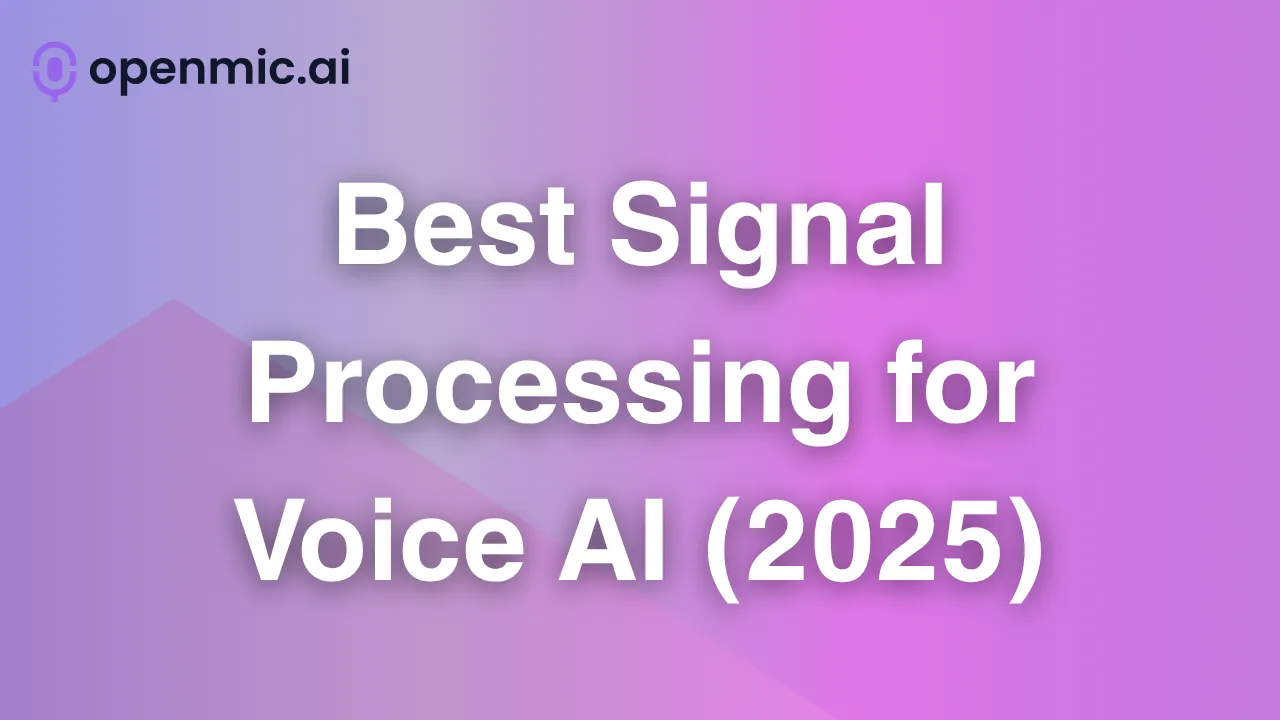
Best Signal Processing for Voice AI (2025)
Voice AI technology has evolved dramatically from the robotic, mechanical-sounding systems of the past to today's sophisticated agents that engage in natural, human-like conversations. At the heart of this transformation lies signal processing—the complex technical framework that converts spoken words into digital data and back into intelligible speech.
Understanding signal processing is crucial for businesses evaluating AI voice solutions. The quality of signal processing directly impacts conversation clarity, response accuracy, and overall user experience. This technical deep-dive explores how signal processing works in AI voice agents and why it matters for your business applications.
What is Signal Processing in Voice AI?
Signal processing in voice AI refers to the mathematical and computational methods used to analyze, modify, and synthesize audio signals. When someone speaks to an AI voice agent, their voice creates sound waves that must be captured, converted to digital format, analyzed for meaning, and then synthesized back into natural-sounding speech responses.
This process involves multiple sophisticated steps happening in milliseconds. The system must filter background noise, identify speech patterns, extract linguistic information, and generate appropriate responses—all while maintaining natural conversation flow that users expect from modern voice interfaces.

Key Signal Processing Components:
- Audio Capture: Converting sound waves into electrical signals
- Analog-to-Digital Conversion: Transforming continuous audio into discrete digital data
- Noise Reduction: Filtering unwanted background sounds and interference
- Feature Extraction: Identifying relevant speech characteristics for analysis
- Speech Recognition: Converting audio signals into text representation.
- Natural Language Processing: Understanding meaning and generating responses.
- Speech Synthesis: Converting text responses back into natural-sounding audio.
The Signal Processing Pipeline
Stage 1: Audio Input and Preprocessing
The signal processing journey begins when a microphone captures sound waves from the speaker's voice. These analog sound waves undergo immediate preprocessing to optimize them for digital analysis.
Sampling Rate Optimization: Modern voice AI systems typically sample audio at 16 kHz or higher, capturing sufficient detail for accurate speech recognition while maintaining computational efficiency. The sampling rate determines how many times per second the system measures the audio signal's amplitude.
Windowing Functions: The continuous audio stream gets divided into small segments (typically 10-25 milliseconds) using mathematical windowing functions. This segmentation allows the system to analyze speech characteristics without losing important temporal information.
Stage 2: Noise Reduction and Enhancement
Real-world conversations include background noise, echo, and other audio interference that can degrade recognition accuracy. Advanced signal processing techniques address these challenges before speech analysis begins.
Spectral Subtraction: This technique analyzes the frequency characteristics of background noise and mathematically removes similar frequencies from the speech signal. The system continuously updates its noise profile to adapt to changing acoustic environments.
Echo Cancellation: Particularly important for phone-based applications, echo cancellation prevents the AI's own speech output from interfering with input recognition. This creates cleaner, more natural conversation experiences.
Stage 3: Feature Extraction and Analysis
The preprocessed audio signal undergoes feature extraction to identify characteristics relevant for speech recognition. This stage transforms raw audio data into mathematical representations that machine learning algorithms can analyze effectively.
Mel-Frequency Cepstral Coefficients (MFCCs): These mathematical features capture the spectral characteristics of human speech in a way that mimics human auditory perception. MFCCs provide robust representation of speech sounds across different speakers and acoustic conditions.
Fundamental Frequency Analysis: The system identifies pitch patterns and intonation that convey emotional context and speaker characteristics. This information helps generate more natural and appropriate response synthesis.
Platform Comparison: Signal Processing Excellence
The Business Impact of Signal Processing Quality
Customer Experience and Trust Building
Superior signal processing directly impacts how customers perceive your business during voice interactions. Clear, natural-sounding conversations build confidence and trust, while poor audio quality or robotic responses create negative impressions that damage business relationships.
Research Data: According to a 2024 study by the Voice Marketing Institute, 73% of consumers judge business credibility based on voice interaction quality. Companies using high-quality voice AI see 40% higher customer satisfaction scores compared to those with basic implementations.
Operational Efficiency Gains
Advanced signal processing enables more accurate speech recognition, reducing errors that require human intervention. This accuracy translates directly to operational cost savings and improved automation effectiveness.
Performance Metrics: OpenMic AI's advanced signal processing achieves 97% speech recognition accuracy in typical business environments, compared to 89% for basic implementations. This 8% improvement reduces human intervention requirements by approximately 45%.
Competitive Differentiation
In crowded markets, superior voice interaction quality provides sustainable competitive advantages. Businesses using advanced signal processing platforms differentiate themselves through consistently professional customer experiences.
Technical Implementation Considerations
Infrastructure Requirements
Signal processing quality depends heavily on underlying infrastructure capabilities. Cloud-based platforms like OpenMic AI provide optimized processing power and global distribution that ensures consistent performance regardless of user location.
Computational Resources: Real-time signal processing requires significant computational power. Advanced algorithms for noise reduction, echo cancellation, and speech synthesis demand processing capabilities that exceed most on-premises solutions.
Network Optimization: Signal processing quality degrades with network latency and packet loss. Professional platforms implement adaptive algorithms that maintain performance across various connection qualities.
Integration Complexity
The sophistication of signal processing algorithms often correlates with implementation complexity. Platforms that abstract this complexity while maintaining high quality provide the best value for business applications.
Development Time: OpenMic AI's pre-optimized signal processing eliminates months of custom development time required by developer-focused platforms. Businesses can deploy professional voice solutions immediately rather than investing in technical optimization projects.
Future Developments in Voice Signal Processing
Machine Learning Enhancement
Modern signal processing increasingly incorporates machine learning algorithms that adapt to specific acoustic environments and user patterns. These adaptive systems continuously improve performance based on real-world usage data.
Continuous Learning: Advanced platforms analyze conversation patterns to optimize signal processing parameters for specific use cases. This automated optimization ensures peak performance without manual tuning requirements.
Real-Time Processing Improvements
Ongoing research focuses on reducing signal processing latency while maintaining quality. Sub-100ms response times represent the next frontier for truly natural voice interactions.
Hardware Acceleration: Specialized processing units designed for AI workloads enable more sophisticated signal processing algorithms without compromising response speed.
Measuring Signal Processing Performance
Key Performance Indicators
Word Error Rate (WER): Measures speech recognition accuracy under various conditions. Industry-leading platforms achieve WER below 3% in optimal conditions.
Response Latency: Time from speech input completion to response generation. Professional applications require latency below 300ms for natural conversation flow.
Audio Quality Metrics: Technical measurements including signal-to-noise ratio, frequency response, and harmonic distortion that determine perceived voice quality.
Choosing the Right Signal Processing Platform
Business Requirements Assessment
Different applications require varying levels of signal processing sophistication. Customer-facing voice agents demand higher quality than internal automation systems, while regulated industries may require specific compliance features.
Use Case Matching: Evaluate platform capabilities against specific business requirements rather than generic features. Professional platforms provide detailed specifications that enable accurate capability assessment.
Total Cost of Ownership
Signal processing quality impacts long-term operational costs through improved accuracy, reduced human intervention, and enhanced customer satisfaction. Higher upfront platform costs often generate superior ROI through operational efficiency gains.
ROI Calculation: Consider implementation time, ongoing maintenance requirements, and performance optimization needs when comparing platform costs. Simplified deployment and management often justify higher per-minute usage costs.
Conclusion: Signal Processing as Competitive Advantage
Signal processing excellence forms the foundation of effective AI voice agents. While basic implementations may suffice for simple automation tasks, professional business applications require sophisticated signal processing that creates natural, trustworthy customer interactions.
OpenMic AI's advanced signal processing architecture delivers the performance, reliability, and ease of implementation that modern businesses need. Our platform abstracts technical complexity while providing industry-leading voice quality and response speed that differentiate your business in competitive markets.
The choice of voice AI platform ultimately determines customer experience quality and operational efficiency. Don't let suboptimal signal processing compromise your business communications.
Ready to experience the difference that advanced signal processing makes? Contact OpenMic AI today to schedule your demonstration and discover how superior voice technology can transform your customer interactions and drive business growth. Try Now!
Explore related blogs
.png)
Voice AI for Mass Tort Lawyers: How Conversational AI Is Revolutionizing Case Intake & Client Engagement
.png)
Top 5 AI Answering Services for Law Firms in 2025 (24/7 Reception & Intake)
.png)
Top 5 White-Label Voice AI Platforms in 2025 (Best for Agencies & SaaS Providers)
Let AI Handle Your Phones So You Can Focus on Growth
Start your free trial and see how OpenMic’s AI voice agents can streamline calls, boost conversions, and deliver fast, 24/7 customer service — without hiring more staff.






.svg)